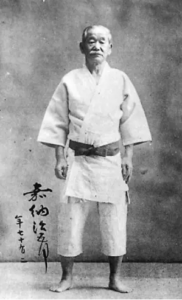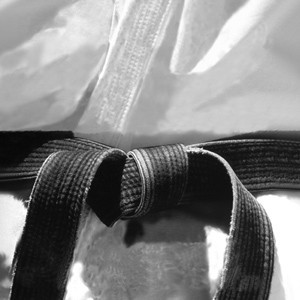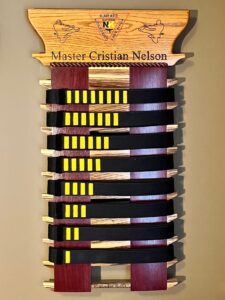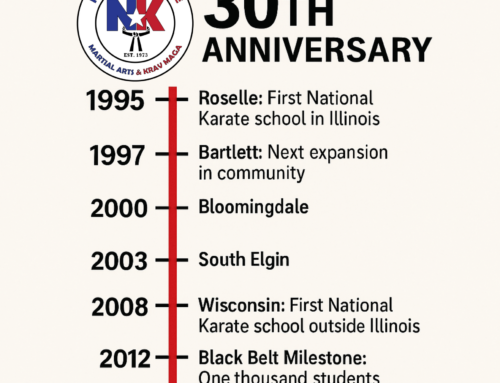
Karate is a Japanese martial art with a rich, ancient history. The origin of the word “Karate” breaks down into “Kara,” meaning “empty,” and “te,” meaning hand. Joined together, “Empty hand” refers to the art of hand-to-hand combat.
Like various Asian martial arts, the origin of karate may be ancient, but the way individuals practice it today is modernized. Some accounts trace Karate back to martial arts techniques learned from Chinese Shaolin monks; others credit Karate’s origins to trade routes between the two countries in the 1300s bringing Chinese visitors who introduced their martial arts techniques to the island of Okinawa.
Japan banned weapons in Okinawa in 1609, resulting in continued practice and refinement of empty-hand fighting techniques. Many of these techniques represent the basis for modern teachings in Karate schools.
Although practitioners have studied the art of Karate in varied forms for a millennium, a well-known component of the art today is relatively new: belt colors in Karate. The first use of colored belts can be traced back to the 1880s with the founder of Judo, Dr. Jigoro Kano. Originally, Kano used only two colors, white and black – students wore white belts while instructors wore black.

Dr. Jigoro Kano
Legend holds that as the white belt student trained, the belt would become soiled and gradually turn darker and darker. Students were not allowed to wash their belts because it was believed that you would wash off your martial arts knowledge. So, as the white belt became soiled from training, it would become darker. For instance, as the white belt became discolored from perspiration it would give it a yellow appearance. Then perhaps in grappling exercises the belt would get grass stained giving it a green hue. An occasional bloody nose could have added red to the belt. And after practicing throws in the dirt the belt would turn brown. And after several years of training the belt would become so soiled that it would look black and at that point the student was considered an expert Black Belt!
It makes for an interesting story but in actuality that explanation of the origin of colored karate belts is an urban myth.
In truth, the colors between white and black were added in the 1930’s by Tae Kwon Do and Jiu Jitsu practitioners to give students recognition of their level of skill and knowledge. Additionally the colored belts provided distinction between beginners, intermediate and advanced students.
The Karate Belts in Order

These martial arts belts have no buckles or clasps. Instead, students wrap them around their waist and tie in front with special knots to secure them around their waists.
The belt colors in Karate acknowledge the expertise and rank of anyone practicing and performing the martial art. While most people understand that a “Black Belt” represents the expert level of martial arts, what do the other colors mean? If you’re in a Karate class, how can you know which of your peers is ranked higher than the rest? What is the Karate belt order? We can help with all of these questions.
From start to finish, there are nine solid color belts in Karate, from white to black. Many martial arts systems also have stripe belts that denote a higher level of that belt color which would break up the goal of Black Belt into smaller baby steps which is more conducive to learning. Each color in the Karate belt order represents a different level of skill and experience. White is the beginner’s belt, and black represents an advanced student’s belt. However, there is more than one black belt level in Karate which we will address toward the end of this article.
No Belt
The absolute beginner starts without a belt. Just as the beginner has no knowledge of martial arts, they also have “no belt”. The beginner student will wear the martial arts uniform or “gi” but without a belt. This symbolizes that they are a blank slate ready to be filled with martial arts knowledge.
White Belt
After the beginner learns the basics of the art, their instructor will award them for the first rank in karate, the White belt. This belt symbolizes that they are a real karate student at the very beginning of their martial arts journey.
Every martial artist begins as a student. Whether these individuals are children, teenagers or adults, it does not matter, all students will begin their martial arts journey with a white belt.
Gold Belt
When a student shows proficiency at the basics they can earn their gold belt and move up to the next level. At this point of their training the student will be introduced to a more advanced curriculum often including a classical “form” or “kata”. The yellow color symbolizes light, demonstrating that a Karate student remains open to facing possible challenges, methods, and techniques.
Green Belt
The green belt color represents growth as students continue to grow and progress in martial arts. At this point many styles feel that the student is proficient enough to be introduced to sparring or fighting with controlled contact. Sparring is considered the best form of self-defense training because you learn how to move out of the way to avoid an attack and when to move in with a counter attack.
Purple Belt
A purple belt represents how a blue sky begins to darken and change at dawn. Karate practitioners at this level are gaining a more profound understanding and knowledge of the art and are considered “intermediate” students. These students are moving up through the ranks and are on their way to becoming self-defense proficient.
Blue Belt
The fourth level, blue belt symbolizes the sky. At this level, students understand various karate moves, striving to refine their gained skills.
Students holding a blue belt will start to gain advanced Karate knowledge, learning and mastering the most basic techniques. Blue belt training commonly focuses on refining learned techniques with increased speed and power while learning new moves and advancing to higher levels. The sky’s the limit.
Red Belt
The red belt represents the sun’s strength, as these students have mastered the basic and intermediate techniques. The red belt is a graduation into the “advanced” level of their martial arts training. The red belt is often called the “self-defense belt” because they have gained a level of proficiency that could be capable of defending themselves from an attacker.
Brown Belt
As a seed fully matures and ripens, it will turn brown. The brown belt shows a student maturing into their martial arts practice, signifying their readiness to enjoy the ripe fruits of their efforts. Depending on a school’s Karate system, this seventh belt displays a student’s maturity in skill and technique.
Black Belt
The Black Belt remains the highest, most coveted rank in the Karate belt order and typically takes approximately three years of training to achieve this goal. This belt denotes that a student traveled through the entire ranking system and is recognized as a very special achievement of mind and body. Black Belt holders are typically considered Karate experts with enough experience to teach other students Karate techniques and philosophy. Although the Black Belt is the ninth and final belt, it does not represent the last rank a martial artist can earn.
The 10 Degrees of a Black Belt
To the true martial artist Black Belt is not considered the end of their training but rather the beginning. While earning a Black Belt may be on the bucket list of many, to the martial artist karate is a way of life and something they endeavor to do for a lifetime. The martial artist can obtain 10 degrees of Black Belt in a lifetime of commitment to self improvement:
- First Degree (Sho-dan) – While technically a Black Belt is recognized as an expert in self defense, among the fraternity of Black Belts, the First-Degree Black Belt is considered a beginner.
- Second Degree (Ni-dan) – The Second-Degree black belt continues to master the art and must train for a minimum of two years as a Black Belt. The continued training makes the 2nd Degree a seasoned martial artist.
- Third Degree (San-dan) – This rank is achieved after three more years of training as a second degree Back Belt or five total years as a Black Belt.
- Fourth Degree (Yon-dan) – An award for mastery in martial arts with readiness to teach others. Achieved after four more years of training as a third degree or nine years as a practicing Black Belt.
- Fifth Degree (Go-dan) – After seventeen years of diligent training (3 years as a student and 14 years as a Black Belt) 5th Degree is finally the level at which the title “Master” is earned. A 5th Degree Black Belt is someone who has procured a “mastery” of the martial arts through years of training and instruction. In addition to the physical skills and knowledge, a Master of the martial arts must also be able to impart their knowledge to others. One of the tenants of the martial arts has always been that you understand the art deeper when you teach it to someone else. To this end, the person attaining the Master rank must show proficiency in the classroom and also as a tournament official.
- Sixth Degree (Roku-dan) – This level of Black Belt is achieved six years after 5th Degree or twenty years as a Black Belt. This level is for Karate masters who understand karate’s true essence and the ability to “give back” to the the sport by training others and advancing the martial arts to the next generation.
- Seventh Degree (Nana-dan) – Achieved seven years after 6th Degree or after twenty-seven years as a Black Belt. This level is for experienced karate masters with a deep understanding of the martial art. By this time, the 7th Degree Black Belt probably has “martial arts grandchildren”. That is, their students who have achieved Black Belt have trained students that have earned Black Belt and become the original instructors “martial arts grandchildren”. Thus carrying on the legacy of martial arts that has been passed down from instructor to student for nearly three thousand years!
- Eighth Degree (Hachi-dan) – Earned after eight years as a 7th Degree or thirty-five years as a Black Belt. This belt is reserved for Masters who have practiced the art for almost a lifetime and have made an impact on the martial arts world. At this level the promotion is based on what the master has done for the sport through instruction, competition, and pouring into others over a lifetime.
- Ninth Degree (Kyu-dan) Earned nine years after 8th Degree or forty-four years as a Black Belt. This level of Black Belt is extremely rare and the 9th Degree Master has emerged as a leader and respected elder in the martial arts world.
- Tenth Degree (Ju-Dan) – This is the highest and most prestigious rank, awarded to masters who have given a lifetime to the furtherance of the martial arts and have demonstrated a lifetime of significant achievement. They have poured into their students and martial arts system the life lessons of honor, respect, courage and instilled in others the indomitable spirit of the Black Belt. “It is a humbling burden that can only be born by the most deserving, the most strong, ardent and caring of humans.”(SJ) If deserving, this rank takes a minimum of fifty-four years as a Black Belt! There are probably only a dozen or so true 10th Degrees in the United States. Amazingly, the National Karate schools actually have two 10th Degree Black Belts! Grand Master John Worley and Grand Master Larry Carnahan are two of the most influential martial artists in America. Click Here to read about their 10th Degree promotion.
Start Your Martial Arts Journey
If you have not begun a martial arts journey yet, you’ll start where everyone does–without a belt. However, the number of belts you achieve doesn’t matter nearly as much as the skills you will learn and master in this life-changing experience.
Rated the “Best Martial Arts School” in the Chicago suburbs for over a decade, you’ll find that National Karate is a family-friendly martial arts school producing confident individuals and quality martial artists.
We proudly offer martial arts classes for children and adults in Illinois, playing an essential role in the lives of karate practitioners at all levels. To learn more about martial arts classes with the National Karate team and how we can assist you, contact us today for additional information.
Note 1: National Karate’s Belts in Order are White, Gold, Green, Purple, Blue, Blue with Red Stripe, Red, Red with Brown Stripe, Brown, Brown with Single Black Stripe, Brown with Double Black Stripe and Black Belt.
Note 2: Some martial arts systems will add an orange belt. Some systems will reverse the purple and blue belt order.






